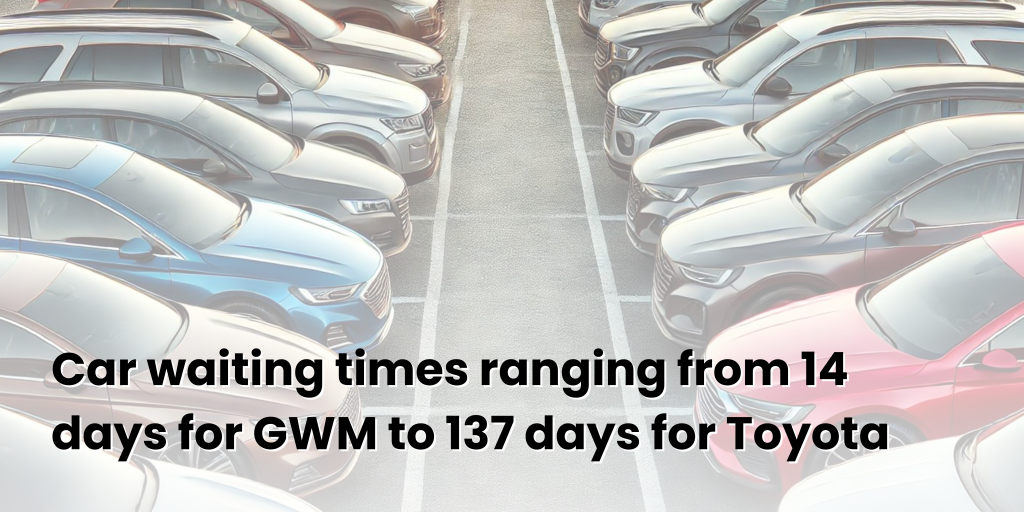I’ve got a diverse and (I’m not kidding), a BUMPER newsletter for you this month, covering best interest rates, architects, business acquisitions, home loans, interest rates, the property market and the car market.
- Best interest rates
- Renos, architects – and, bill shock!
- Victorian Planning Processes – about to change?
- RBA gives rates guidance
- Spring selling season preview
- How construction loans work
- Car deliveries averaging 65 days
- Business acquisitions – a few clues for borrowing
You can also check our blog last month: 2408 August – Monthly Newsletter: Size matters – loans are increasing I Best rates I SMSF and property I Business Tricks and Traps
Now, let’s get started!

Date: 2 September 2024
Owner Occupiers:
• Fixed Rates from 5.69% – 3 years Fixed (Principal & Interest – P&I) and 6.19% 2 years Fixed (Interest Only – IO).
• Variable Rates from 5.99% (Principal & Interest – P&I) and 6.39% (Interest Only – – IO: non-construction loans).
Investors:
• Fixed Rates from 5.94% – 3 years Fixed (Principal & Interest – P&I) and 5.94% 2 years Fixed (Interest Only – IO) – interestingly, no difference in the best rate between P&I and IO.
• Variable Rates from 6.19% (Principal & Interest – P&I) and 6.34% (Interest Only – – IO: non-construction loans).

Renos, architects – and, bill shock!
Sometimes, it might seem that hiring an architect will be costly and difficult to negotiate, particularly if you want to pull out because it is all getting too hard and too expensive. So instead, you might decide, ‘Don’t bother.’
Well, I will now let you in on a novel approach – it used to be a secret (until now), but an architect I recently met has developed ‘The Goldilocks Model’. Stay with me – the logic will become clear.
The Goldilocks Model is particularly useful for homeowners who are considering a renovation but are unsure how much it will cost or what they can afford. (As an aside, I can tell you what you can afford to borrow – just saying….).
For a fixed fee, this innovative architect develops three options: the dream renovation, the budget reno and what she calls the Goldilocks version which is somewhere in between (fairytales live on 😉).
In this way, clients can choose which option suits their budget best and then voila, she implements for a fixed fee (not a percentage of the total cost), the agreed plan.
Her name? Audry Whisker (I met her shortly after I had just attended a whiskey tasting so you can imagine my confusion regarding her last name). Her business is Whisker Architecture.
If you would like an intro to Audrey or some of the other great architects I know (John Herniman from the Herniman Group is another high-quality architect who has worked on many larger commercial projects – and he has also been an expert witness – handy to know!), I’ll be happy to do the honours.

Victorian Planning Processes
About to change?
Hot off the press from John Herniman’s email service (I mentioned him above as an architect of note).
In The Age Newspaper on 31 August 2024, there was an article identifying a series of “leaked” documents showing that the State government is about to substantially change the planning laws to meet targets for delivery of new homes, units and apartments.
This will affect all people involved in property in Victoria.
It is not planning law yet but they are proposing in General Residential Zoning:
• Substantial reduction of neighbours’ ability to appeal if the proposal meets new “deemed to comply” regulations. Developers will still be able to appeal to VCAT.
• The removal of “neighbourhood character” rules.
• Reduction of waiting times.
• Heights and setbacks will change substantially to enable 3 stories with 11m height limit and reduced setbacks from side boundaries and external walls to go straight upwards without the requirement for the expensive “wedding cake” design. This current B17 standard in clause 55 of the planning scheme is represented by the dashed blue line, whilst the red highlights the new planning provisions.
Watch this space.
Like to talk to John? Let me know and I will organise an intro.

Reserve Bank of Australia (RBA) Governor Michele Bullock has indicated that the RBA board is unlikely to lower the cash rate for at least the next six months.
During a press conference, Governor Bullock noted that while the market seems to expect rate cuts in 2024, this outlook is not realistic. “I think the board’s feeling is that the near term, by the end of the year and the next six months, given what the board knows at the moment and given what the forecasts are, that that doesn’t align with their thinking about interest rate reductions at the moment,” she stated.
The board’s primary goal is to bring inflation, currently at 3.8%, down to its target range of 2-3%. They are unlikely to consider reducing the cash rate until inflation has either fallen within this target range or shown signs of moving toward it.
However, in its Statement on Monetary Policy released in early August, the RBA acknowledged that inflation is “proving persistent.”
“Inflation is expected to take slightly longer to reach the target than was thought at the time of the May forecasts. Underlying inflation is forecast to return to the target range of 2-3% in late 2025 and approach the midpoint in 2026. This is a slightly slower return to target than forecast in May and is due to greater inflationary pressures in the economy,” the RBA explained.

Based on historical trends, we can expect a rise in both buying and selling activity during the year’s final quarter.
CoreLogic data shows that over the past decade, there have been 8.3% more sales in spring compared to winter, and 18.2% more new listings. However, Eliza Owen, Head of Research at CoreLogic, pointed out that broader market forces can sometimes overshadow these seasonal patterns.
“Looking at spring of 2024, it is possible we could see demand come under pressure from a continuation of high interest rates, slowing economic conditions and low consumer sentiment, and sellers may struggle in two of the state capitals in particular,” she said.

So what does this mean for you?
Melbourne and Hobart:
- In the three months to July, new listings exceeded sales (supply was greater than demand).
- Buyers likely have more options, resulting in stronger negotiating positions.
Sydney, Brisbane, Perth, and Adelaide:
- Sales exceeded new listings (demand was greater than supply).
- Buyers may have fewer options, leading to less market power.

Securing approval is a crucial step in building a new home, a process thousands of Australians undertake each month. In June alone, 13,237 homebuilding approvals were issued nationwide, with around 70% for houses and the remainder for apartments, townhouses, and other dwellings.
If you’re planning to build a home, your first step should be to consult with a broker before designing your home and submitting plans for approval. This will help you understand how much you can borrow and the repayment terms to expect.
If your project proceeds, the funds won’t be provided in a lump sum. Instead, they will be released in five stages as the project reaches different milestones. During this time, your loan will be interest-only, and interest will only be charged on the amount disbursed so far.
Once construction is complete, your loan will convert to a standard home loan, with both principal and interest repayments, leading to an increase in your monthly payments.
The five milestone when your funds are released
If your project moves forward, the funds will be released in five stages, aligned with key construction milestones:
- Slab or Base Stage: Payment is released after the foundation or concrete slab is laid.
- Frame Stage: Funds are provided once the frame of the house, including the walls and roof trusses, is completed.
- Lockup Stage: The next payment occurs when the property is at “lockup,” meaning the external doors, windows, and walls are installed, making the house secure.
- Fixing or Fit-Out Stage: Funds are released when the internal fixtures and fittings are installed, including plumbing, electrical work, cabinets, and tiling.
- Completion or Final Stage: The final payment is made once all work is completed, the council’s final inspection is done, and the builder has issued a certificate of practical completion.

If you’re planning to purchase a new vehicle, be prepared to consider delivery times, as most buyers will need to wait for their new car to arrive.
In June, the brands with the shortest average waiting times were:
- GWM: 14 days
- Subaru: 22 days
- Mazda: 30 days
- Nissan: 40 days
- Skoda: 47 days
Meanwhile, the brands with the longest waiting times were:
- Toyota: 137 days
- BMW: 129 days
- Ford: 120 days
- Kia: 94 days
- Hyundai: 82 days
The average delivery time in June was 65 days. Delivery times have remained relatively stable since November 2023, fluctuating between 63 and 71 days each month. However, this is a significant improvement from the start of 2023, when the average wait time was 137 days.
What about electric vehicles?
The average delivery times for electric vehicles (EVs) during the same period have generally varied by brand and model, but they have often been longer than those for traditional internal combustion engine vehicles due to higher demand, supply chain constraints, and limited production capacity.
As of June 2024, here are some of the average delivery times for popular EV brands in Australia:
- Tesla: Typically ranges from 30 to 90 days, depending on the model and configuration. For example, the Model 3 and Model Y have had shorter waiting periods (around 30–60 days), while the Model S and Model X have experienced longer waits.
- Hyundai (EV models like Ioniq 5 and Kona Electric): Around 90 to 120 days, reflecting a higher demand and limited stock availability.
- Kia (EV6 and Niro EV): Average delivery times have been around 120 days or more, due to high demand.
- BYD (Atto 3): Waiting times have generally been in the range of 60 to 90 days.
- Polestar 2: Delivery times have averaged around 90 to 120 days.
- MG ZS EV: Typically around 30 to 60 days, among the shorter wait times for EVs.
Overall, EV delivery times have often been longer than the average for all vehicles, reflecting the growing demand for electric cars and various supply chain challenges. However, specific wait times can fluctuate significantly depending on model availability, production schedules, and supply chain conditions.

No matter what type of vehicle you choose, I strongly recommend securing your loan through a broker. Opting for dealer finance or going directly to your bank will limit your options and likely result in a higher interest rate. As a broker, I can compare the market on your behalf, increasing your chances of finding a better deal.

Business acquisitions
– a few clues for borrowing
Recently, I have conducted some exploratory work to identify lenders with an appetite for business acquisitions, particularly those willing to fund more than just the “I’m buying a job” business acquisition.
In other words, lenders interested in businesses with strong systems, management teams, and cash flow.
It’s fair to say that the market is relatively limited when it comes to lenders willing to provide business acquisition funding, particularly when the purchase price is north of $1M to $3m and even more so when the purchase price climbs to $10M plus.
However, that doesn’t mean funding isn’t available—you just need to do a bit more due diligence before diving in.
*** Sales warning *** That’s where we come in! We can do the due diligence for you so you are more likely to get a deal done and you are not going to be spending your time, shopping around to the various lenders to find who will do the deal for you. We can even assist you prepare the information required – which, as you can see below, can be quite extensive. Plus, with a background in restructuring means that we have some expertise in negotiation, business structures and operational issues.
The most important thing to remember
The #1 priority for all lenders is:
They want to ensure they get their money back!
While “exit strategy” might not be the first thing a lender mentions to you, trust me — it is the first thing on their mind. As without this requirement, the deal is unlikely to pass their Credit checks.
A lender doesn’t want to recover their money by selling off assets and the business, but they want to be certain that, if everything goes wrong (the expression to hell in a handbasket comes to mind), they will still get their money back.
Lenders don’t earn an equity or upside return on the funds they lend, so while the optimistic and blue sky projections might appeal to equity participants, the lender is primarily focused on ensuring that the base-case projections are solid and reliable.
It’s no surprise, then, that “hard asset” security, such as property, opens up a wider range of lending options and, as a bonus surprise, often comes with lower rates! A rate in the 6.6% range was quoted to me with a 6.19% rate mentioned if the property security was residential – see above for the best rates so you can see this lender is offering very sharp rates for the right business acquisition deal.
On the other hand, other assets such as plant and equipment are less useful for lenders looking to protect their funds, as their value is typically higher only when they are “in situ” as part of the business’s ongoing operations.
In summary, assets provide the lender with reassurance in the worst-case exit strategy, while cash flow offers confidence in the borrower’s ability to repay as planned.
Lender feedback
- Some lenders with a healthy appetite for these deals will go as high as 60% (and perhaps even a touch higher) of the total deal price. With the right security, one even mentioned 100% but that is rarified territory. Others max out at around 30% so it can vary a lot.
- Rates can also vary with one lender indicating that good, quality deals can be priced under 8%. However, others are more in the overdraft range of 10% to 14% – so again, rates can vary a lot.
- One lender’s BDM mentioned that he will get deals done in 2 to 3 weeks plus documentation and settlement – and he has a very high 95% plus deal success with his Credit team. Pretty amazing stats.
Conclusion: Planning in advance and developing the right relationship with the right lender AND the right BDM within the lender who is most likely to be able to assist you can make the world of difference to the deal you obtain.
The 5 Cs of Credit apply
The 5 Cs of credit are key factors that lenders use to evaluate a borrower’s creditworthiness:
- Character: Refers to the borrower’s reputation, credit history, and track record of repaying debts. Lenders assess the borrower’s trustworthiness and reliability.
- Capacity: The borrower’s ability to repay the loan, determined by their income, employment history, current debts, and other financial obligations.
- Capital: The money or assets the borrower invests in a project or purchase. A larger personal investment by the borrower reduces the risk to the lender. Purchasers should be looking to contribute ~30% equity to the acquisition.
- Collateral: Assets or property the borrower offers to secure the loan. If the borrower defaults, the lender can claim the collateral to recover losses.
- Conditions: External factors that might impact the borrower’s ability to repay, such as the state of the economy, industry trends, or regulatory changes. Conditions also refer to the loan’s terms, like the interest rate and amount borrowed.
The devil in the detail with the 5Cs
The 5Cs can be outlined in a well-structured Business Plan that covers the following items. There is no particular order of importance, as all are crucial.
Interestingly, one lender I spoke to who gets most of his business from finance brokers like BIR Finance said that most brokers do not do a good job on providing a lot of the information set out below. Many finance brokers are good at supplying the financials and things like the ATO tax portals but they are not good at ‘selling the story’.
That’s where we are a little bit different.
Having prepared and written a number of Information Memorandums, we understand what it is that lenders are looking for. And not surprisingly, the better the story, the quicker the deal can be approved and the lower the rate.
Some things to provide to a lender:
- SWOT Analysis: Especially important if there are external factors likely to impact the business and industry.
- Information Memorandum: Issued by the vendors, providing a detailed overview of the business. A good IM can even shortcut the work you need to do on your base case Business Plan for the lender.
- Contract of Sale or Heads of Agreement: Specifies what is being purchased, including relevant Intellectual Property and Confidential Information. This is particularly relevant if the IP is located in a separate entity.
- CVs of the Purchasers: Details about who the purchasers are, and their experience in the industry, management, and business acquisitions. Or, as one lender said, if there is a high net worth sponsor for the deal, a lot of potential problems can go away, particularly if they are a guarantor.
- Purchaser’s Net Worth: Information on the purchaser’s financial standing and their ability to access additional equity funding if required.
- Purchaser’s Ability to Contribute to future equity: Demonstrates ongoing capacity to meet financial obligations if they are not working in the business, including the provision of personal tax returns.
- Rationale for Acquisition: Explanation of why the purchasers believe this is a good business for them to acquire.
- Financials: Up-to-date historical financials prepared by an accountant and lodged with the ATO (Income Tax and BAS) add credibility to the underlying values.
- Key Expenses: Detailed information on key expense categories, such as employee costs (including those related to the vendor), which is crucial for verification.
- Working Capital: Aged listings of debtors and payables, along with an understanding of how efficiently the business has managed them (not too high and not too low). Historical ratios are helpful for identifying consistent trends in these levels relative to the size of the business operations.
- Stocktake: A detailed inventory of physical assets being acquired, including descriptions of plant and equipment (e.g., make, model, year of acquisition, serial number).
- Lease Commitments: Details of any operational or financial leases being assigned to the purchaser.
- Projections and Modelling Assumptions: These should clearly demonstrate a return on investment and be transparent and easy to understand. If the success of the planned acquisition relies on untested or unverifiable assumptions beyond historical performance, lenders will be more skeptical about the purchaser’s realism. The projections should also include clear plans for any changes to each functional area of the business, outlining the strategies to be adopted and the key constraints to achievement (e.g., headcount, premises space and location, capital equipment).


